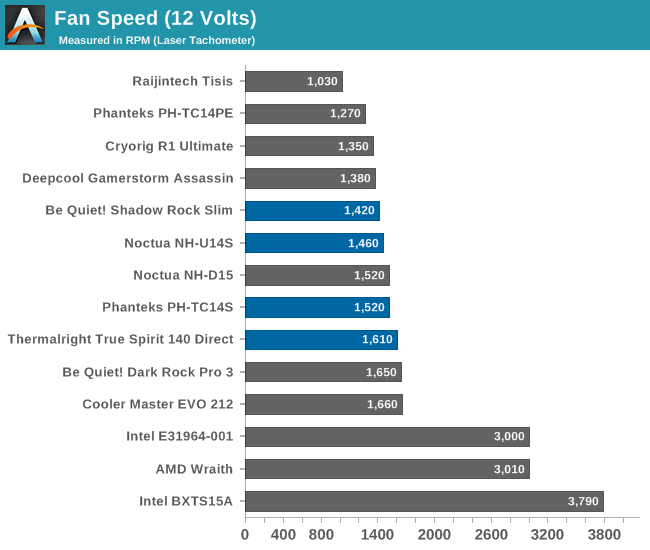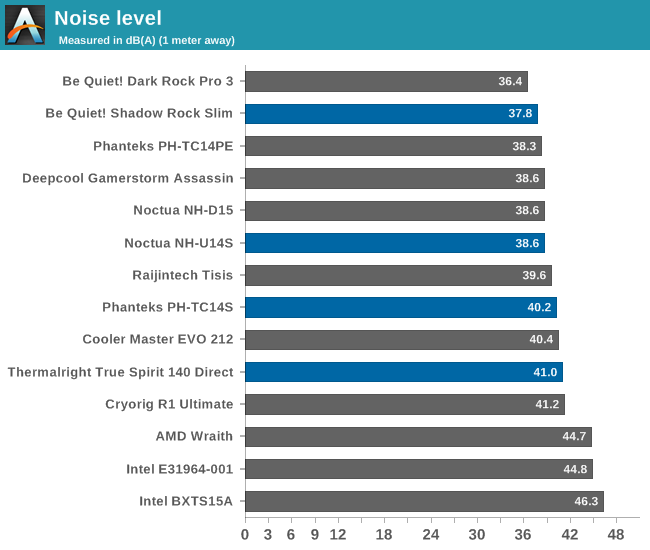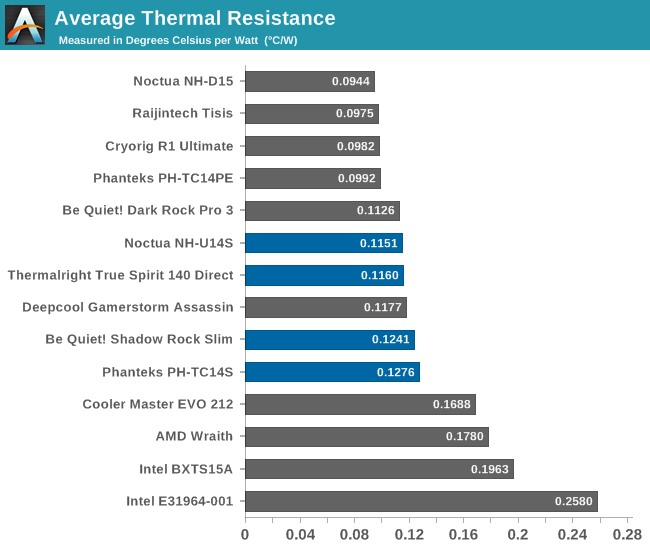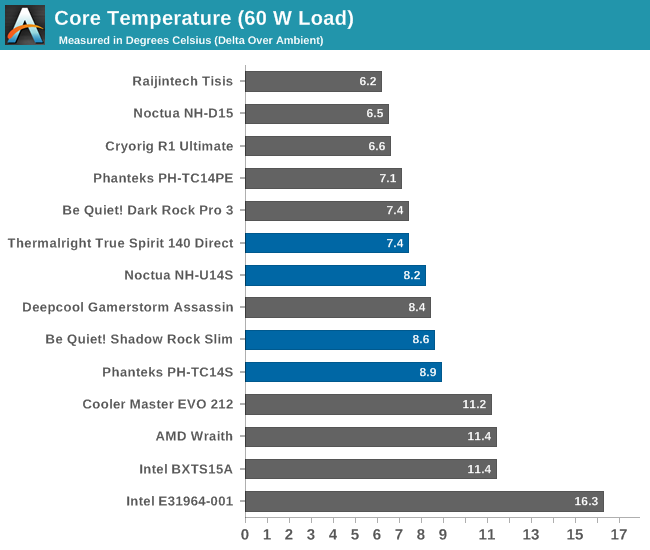The 140mm Slim Tower CPU Cooler Roundup: Thin & Light Done Just Right
by E. Fylladitakis on May 24, 2017 8:00 AM EST- Posted in
- Cases/Cooling/PSUs
- be quiet!
- Noctua
- Phanteks
- Cooler
- Thermalright
Testing Results: Maximum Fan Speed
To start things off, let's take a look at the peak cooling performance of our four tower coolers. We should note that the Phanteks PH-TC14S is once again the oddity of this review, with its fan reaching 1520 RPM. The specifications of the PH-F140HP fan state a very broad maximum speed range of 1300 ± 250 RPM, so our reading is within the fan’s specifications, yet this is the first time that we have encountered a fan spinning that much faster than its rated speed.


With their fans running at their maximum speed, the best overall thermal performance comes from Thermalright’s True Spirit 140 Direct. Noctua’s NH-U14S handles high loads a little better, but Thermalright’s offering has a very strong advantage at lower loads, suggesting more efficient heat transfer due to its direct contact design.

The Be Quiet! Shadow Rock Slim falls a little behind in terms of thermal performance but only by a couple of degrees, which is acceptable considering that it had the lowest noise reading of this review. Considering the overall design of the cooler and that it has a smaller number of heatpipes in comparison to every other cooler in this review, its top speed performance is surprisingly good.

| Core Temperature, Constant Thermal Load (Max Fan Speed) |
Although its thermal performance is satisfactory, the Phanteks PH-TC14S falls behind the other three coolers of this review. It is both slightly louder and less efficient, especially when it has to deal with very high thermal loads. The difference however is small and a more carefully designed revision can easily turn the tables.










74 Comments
View All Comments
guidryp - Wednesday, May 24, 2017 - link
IMO, it looks like the Thermalright is the the winner. It's the least expensive, and up to 150 watts, it keeps the lowest temperature. How many CPUs pull over 150 watts? Especially in real world workloads, not torture testing??JoeyJoJo123 - Wednesday, May 24, 2017 - link
That would seem to be the case here, yes. Performs as well as the Noctua (better than the Noctua at low loads and nearly equal at high loads), while being physically smaller, and cheaper, too.The black and silver finish is relatively attractive, too, but appearances are subjective anyways.
A5 - Wednesday, May 24, 2017 - link
Agreed, and I own the Noctua.I've had Thermalright products in the past and they were excellent as well.
ShieTar - Wednesday, May 24, 2017 - link
That only remains true if the CPU produces power over the same area as the thermal cartridge used in the test. The problem, specifically with Intels latest 4-Cores, is that they generate 100W on a much smaller area. Then the overall cooling capability and the vertical thermal resistance of the cooler become less relevant, and the lateral thermal resistance of the cooler base-plate becomes increasingly critical. That is why an i7-7700K will run much hotter than older CPUs with the same TDP, but much more die area.JoeyJoJo123 - Wednesday, May 24, 2017 - link
You're not wrong, but there's more to that story.It's also partially attributable to Intel's usage of poor TIM between the die and the integrated heatspreader, rather than their older usage of fluxless solder.
Intel's newer chips (due to smaller die sizes and poorer thermal interface for the integrated heatspreader) means that by the time the heat meets the heatsink vs integrated heatspreader contact area, it's not being dissipated as efficiently as older CPU models.
guidryp - Wednesday, May 24, 2017 - link
I think you have the situation backwards. The way the Thermalright excels at lower temperatures and it's direct heatpipe design indicate it has superb transfer from the socket.It only falls behind later when when the smaller heatsink array can't dissipate it as quickly.
Eri Hyva - Wednesday, May 24, 2017 - link
Please, add a test with 9 volts.Arbie - Wednesday, May 24, 2017 - link
Other sites reviewing coolers (eg X-Bit Labs R.I.P.) have found ways to plot cooling ability vs noise level. That makes it much easier to evaluate and choose the best one. IIRC one site even got cost into the same picture. In any case, leaving the reader to separately juggle delta-T and dBA is weak.Galcobar - Thursday, May 25, 2017 - link
Gold standard for standardized testing the efficiency of noise to cooling is Silent PC Review.Unfortunately, the site suffered a serious lack of ad revenue and seemed to go into the media death spiral of lack of readership>lack of revenue>lack of content>lack of readership. Hasn't been a posting since August.
snarfbot - Wednesday, May 24, 2017 - link
Well the article measures perf as shipped which while good is not apples to apples as they all use diff fans. They should be measured separately with the same fan installed into each to take fan speed, voltage and noise out of the equation.